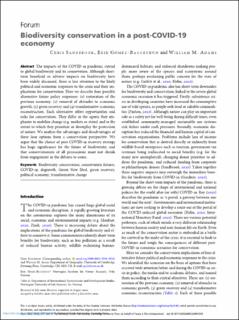| dc.contributor.author | Sandbrook, Chris | |
| dc.contributor.author | Gomez-Baggethun, Erik | |
| dc.contributor.author | Adams, William M. | |
| dc.date.accessioned | 2023-02-01T13:26:45Z | |
| dc.date.available | 2023-02-01T13:26:45Z | |
| dc.date.copyright | | |
| dc.date.copyright | ©The Authors 2022 | |
| dc.date.created | 2022-05-05T14:39:25Z | |
| dc.date.issued | 2022 | |
| dc.identifier.citation | Oryx. 2022, 56 (2), 277-283. | en_US |
| dc.identifier.issn | 0030-6053 | |
| dc.identifier.uri | https://hdl.handle.net/11250/3047756 | |
| dc.description.abstract | The impacts of the COVID- pandemic extend to global biodiversity and its conservation. Although shortterm beneficial or adverse impacts on biodiversity have been widely discussed, there is less attention to the likely political and economic responses to the crisis and their implications for conservation. Here we describe four possible alternative future policy responses: () restoration of the previous economy, () removal of obstacles to economic growth, () green recovery and () transformative economic reconstruction. Each alternative offers opportunities and risks for conservation. They differ in the agents they emphasize to mobilize change (e.g. markets or states) and in the extent to which they prioritize or downplay the protection of nature. We analyse the advantages and disadvantages of these four options from a conservation perspective. We argue that the choice of post-COVID- recovery strategy has huge significance for the future of biodiversity, and that conservationists of all persuasions must not shrink from engagement in the debates to come. Biodiversity conservation, conservation futures, COVID-19, degrowth, Green New Deal, green recovery, political economy, transformative change | en_US |
| dc.language.iso | eng | en_US |
| dc.rights | Navngivelse 4.0 Internasjonal | * |
| dc.rights.uri | http://creativecommons.org/licenses/by/4.0/deed.no | * |
| dc.title | Biodiversity conservation in a post-COVID-19 economy | en_US |
| dc.title.alternative | Biodiversity conservation in a post-COVID-19 economy | en_US |
| dc.type | Peer reviewed | en_US |
| dc.type | Journal article | en_US |
| dc.description.version | publishedVersion | en_US |
| dc.subject.nsi | VDP::Matematikk og naturvitenskap: 400 | en_US |
| dc.subject.nsi | VDP::Mathematics and natural scienses: 400 | en_US |
| dc.subject.nsi | VDP::Matematikk og naturvitenskap: 400 | en_US |
| dc.subject.nsi | VDP::Mathematics and natural scienses: 400 | en_US |
| dc.subject.nsi | VDP::Samfunnsvitenskap: 200::Økonomi: 210::Samfunnsøkonomi: 212 | en_US |
| dc.source.pagenumber | 277-283 | en_US |
| dc.source.volume | 56 | en_US |
| dc.source.journal | Oryx | en_US |
| dc.source.issue | 2 | en_US |
| dc.identifier.doi | 10.1017/S0030605320001039 | |
| dc.identifier.cristin | 2021839 | |
| cristin.ispublished | true | |
| cristin.fulltext | original | |
| cristin.qualitycode | 1 | |

